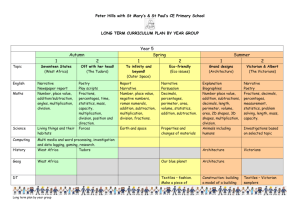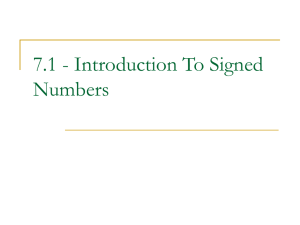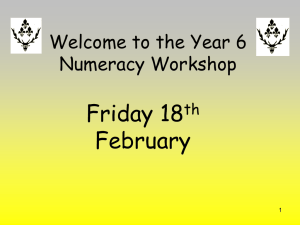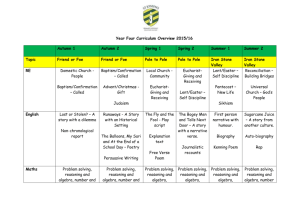MATH 167 - Baton Rouge Community College
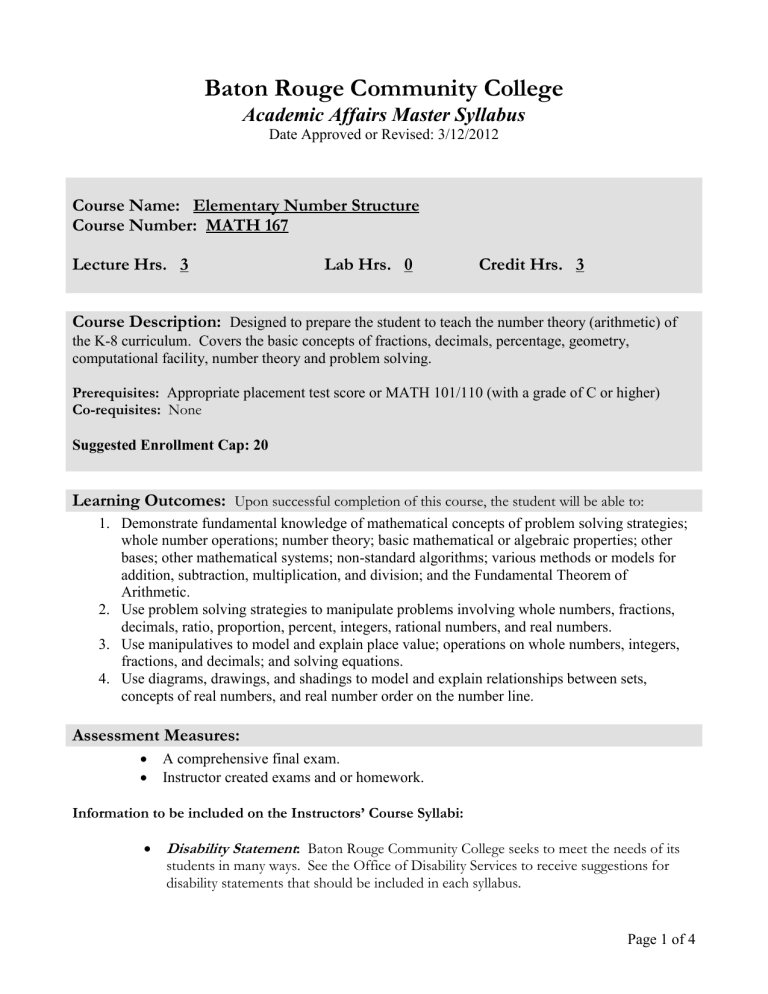
Baton Rouge Community College
Academic Affairs Master Syllabus
Date Approved or Revised: 3/12/2012
Course Name: Elementary Number Structure
Course Number: MATH 167
Lecture Hrs. 3 Lab Hrs. 0 Credit Hrs. 3
Course Description:
Designed to prepare the student to teach the number theory (arithmetic) of the K-8 curriculum. Covers the basic concepts of fractions, decimals, percentage, geometry, computational facility, number theory and problem solving.
Prerequisites: Appropriate placement test score or MATH 101/110 (with a grade of C or higher)
Co-requisites: None
Suggested Enrollment Cap: 20
Learning Outcomes:
Upon successful completion of this course, the student will be able to:
1.
Demonstrate fundamental knowledge of mathematical concepts of problem solving strategies; whole number operations; number theory; basic mathematical or algebraic properties; other bases; other mathematical systems; non-standard algorithms; various methods or models for addition, subtraction, multiplication, and division; and the Fundamental Theorem of
Arithmetic.
2.
Use problem solving strategies to manipulate problems involving whole numbers, fractions, decimals, ratio, proportion, percent, integers, rational numbers, and real numbers.
3.
Use manipulatives to model and explain place value; operations on whole numbers, integers, fractions, and decimals; and solving equations.
4.
Use diagrams, drawings, and shadings to model and explain relationships between sets, concepts of real numbers, and real number order on the number line.
Assessment Measures:
A comprehensive final exam.
Instructor created exams and or homework.
Information to be included on the Instructors’ Course Syllabi:
Disability Statement: Baton Rouge Community College seeks to meet the needs of its students in many ways. See the Office of Disability Services to receive suggestions for disability statements that should be included in each syllabus.
Page 1 of 4
Grading: The College grading policy should be included in the course syllabus. Any special practices should also go here. This should include the instructor’s and/or the department’s policy for make-up work. For example in a speech course, “Speeches not given on due date will receive no grade higher than a sixty” or “Make-up work will not be accepted after the last day of class.”
Attendance Policy: Include the overall attendance policy of the college. Instructors may want to add additional information in individual syllabi to meet the needs of their courses.
General Policies: Instructors’ policy on the use of things such as beepers and cell phones and/or hand held programmable calculators should be covered in this section.
Cheating and Plagiarism: This must be included in all syllabi and should include the penalties for incidents in a given class. Students should have a clear idea of what constitutes cheating in a given course.
Safety Concerns: In some programs this may be a major issue. For example, “No student will be allowed in the safety lab without safety glasses.” General statements such as, “Items that may be harmful to one’s self or others should not be brought to class.”
Library/ Learning Resources: Since the development of the total person is part of our mission, assignments in the library and/or the Learning Resources Center should be included to assist students in enhancing skills and in using resources. Students should be encouraged to use the library for reading enjoyment as part of lifelong learning.
Expanded Course Outline:
I. Number systems.
A. Define the following sets of number: natural, whole, integers, rationals, irrationals, reals.
B.
Be able to categorize numbers into the above sets.
C.
Know and be able to use problem-solving strategies to solve problems.
D.
Explain the difference between cardinal and ordinal numbers.
E.
Write a number in expanded notation ( with and without exponent notation)
F.
Use base ten blocks to explain place value and operations on whole numbers.
G.
Work with other bases (base two through base twelve) to show an understanding of place value and operations.
H.
Perform arithmetic in other bases (two – twelve).
II. Logic
A. Understand and use the notation for union of sets, intersection of sets, elements of sets, difference of sets, Cartesian products of sets and subsets.
B. Understand and explain how to use set models for addition, subtraction, multiplication, and division.
C. Given specific sets, find their intersections, unions, differences, Cartesian products and/or subsets.
D. Use Venn diagrams to demonstrate relationships between sets.
Page 2 of 4
III. Real Number System and other Number systems
A. Understand and explain how to use number line models for addition, subtraction, multiplication, and ordering of whole numbers.
B. Understand and explain how to use each of the following models for subtraction: take- away model, missing addend model, comparison model.
C. Understand and explain how to use each of the following models for multiplication: repeated addition model, rectangular array, Cartesian product model.
D. Understand and explain how to use each of the following models for division: repeated subtraction model, partitive model, measurement model, missing factor model.
E.
Understand and explain or demonstrate the commutative property.
F.
Use and identify the following properties: closure commutative, associative, identity.
Do this for various sets of numbers.
G.
Know Roman numerals and be able to contrast that numeration system with the Hindu-
Arabic system.
H.
Know why the Hindu-Arabic system is a called a “decimal” system.
IV. Problem solving
A.
Be able to explain why various methods for mental math work, i.e., state properties or processes which are used for given examples (e.g. distributive property, compensation, compatible numbers).
B.
Be able to use the following non-standard algorithms: lattice multiplication, scratch addition, expanded multiplication (showing sub-“totals”), and addition from left to right to explain your choices for estimates.
C.
Be able to use estimation to get approximate answers for application problems. Be able to explain your choices for estimates.
V. Number Theory
A.
Define and recognize prime numbers and composite numbers.
B.
Use the following terminology correctly: factor tree, prime factorization, divides, does not divide, divisor, factor, multiple, is divisible by.
C.
State the Fundamental Theorem of Arithmetic.
D.
Find the prime factorization of a natural number greater than one.
E.
Know and use the tests for divisibility by 2, 3, 4, 5, 6, 8, 9, 10 12, 15.
F.
Know relationships dealing with divisibility, sums, differences, and products, and recognize their use (text p. 181, last theorem; p. 184 third theorem).
G.
Find the greatest common factor and least common multiple by:
1.
Listing (set intersection method)
2.
Concentrating on factors ( or multiples) of one of the two numbers
3.
Prime factorization method
VI. Fractions
A. Understand the concept of a fraction and explain it via drawings or shadings on drawings.
B.
Illustrate equality of fractions via drawings.
C.
Write a fraction in reduced form.
D.
Order fractions using a variety of methods. Be able to place fractions on a number line appropriately.
E.
Explain why we need common denominators to add or subtract fractions.
F.
Perform multiplication and division of fractions.
Page 3 of 4
G.
Understand the concepts of addition, subtraction, multiplication and division of fractions and explain the operations via drawings, shading on drawings, or with manipulatives.
H.
Write a word problem which would use a particular operation on fractions.
I.
Solve problems which would require proportional reasoning (ratios and proportions).
VII. Percents and Decimals
A.
Explain the concept of percent via 10 by 10 grids.
B.
Write a word problem which would be solved using a particular percent relationship.
C.
Work problems dealing with percent.
D.
Explain the relationship between percent and fractions.
E.
Understand the concepts of addition, subtraction, multiplication, and division of decimal numbers by referring back to their fractional equivalents and explain the operations via drawings or shading on drawings.
F.
Perform addition, subtraction, multiplication, and division of decimal numbers.
G.
Order decimals from smallest to largest.
VIII. Operations with Integers, Rational numbers, Irrational numbers and Real Numbers
A.
Explain the concepts of ordering of integers with the number line
B.
Explain the concepts behind addition, subtraction, multiplication, and division of integers via colored discs or +/- chips and with the number line model.
C.
Write a word problem which would be solved using a particular integer relationship.
D. Work problems dealing with integer values.
E. Be able to order rational and real numbers
F. Be able to solve equations using concrete/pictorial representations (cups and chips)
Page 4 of 4
